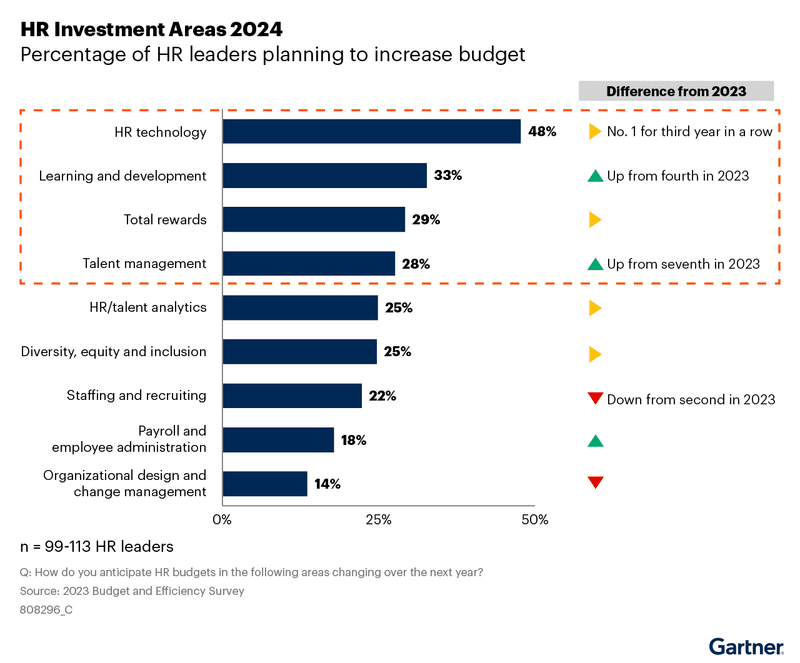
What is an Applicant Tracking System (ATS)?
An applicant tracking system (ATS) is exactly what its name suggests: It’s a software system that tracks job applicants through a recruitment process. At least that’s what applicant tracking systems started as. Essentially an ATS was simply a database designed for recruiters to hold all their candidate and job data. With the first ATS’s released before the internet was even widely used, every application to every job was a manual data entry. Today, we’re luckily a far cry away from that!
Today, applicant tracking systems are largely still based on a database-like foundation of candidates and jobs linked to each other but enable recruiters to automate, standardize, ensure compliance, collaborate with stakeholders, reduce bias, and report accurately - and much more.
Understanding the Evolution of Applicant Tracking Systems
Seven years ago Deloitte’s annual Global Human Capital Trends report was titled Rewriting the rules for the digital age. “Robotics, AI, And Cognitive Computing Are Changing Organizations Even Faster Than We Thought” read a Forbes headline in the same year. HR technology, like applicant tracking systems, is far from a new concept and, as we can see from these two 2017 publications, we’ve known that it’s become more and more important for years.
And yet, here we are today - seven years later - and 56% of HR leaders still say their technology doesn’t meet current or future business needs. This may seem pretty grim but it’s not quite that simple and that’s why you need to understand the evolution of HR technology like applicant tracking systems.

2024 was the third year in a row that Gartner identified HR technology as the highest investment HR teams are likely to make. The applicant tracking systems market is projected to grow by 9.9% annually between now and 2031. And no, companies aren’t spending 3.03 Billion on ATSs that are still just databases with prettier UX than spreadsheets.
While technology as a whole continued to evolve, the world of recruiting has also evolved massively in the last few years. Every recruiter today will tell you that we’ve shifted towards candidate-led recruitment, companies have shifted towards skills-based hiring and good employer brands are an essential part of this world. Add in that we have Gen Z stepping in and Millennial managers are, as expected, not sticking to the status quo of what came before them. And as the world of recruitment changed, recruiters’ approaches have had to shift to being strategic, rather than order-taking. A new world and a new approach necessitated this ATS evolution, and they did but adoption in companies hasn’t kept up with the pace of all these changes.
Many organizations, especially large organizations are playing catch up while smaller, tech start-ups are leading the inevitably tech-powered talent race.
How Does an ATS Improve Hiring?
Efficiency
Applicant tracking systems streamline and speed up your hiring process. This alone would be a win but an ATS also allows hiring processes to run smoothly without recruiters doing as many hands-on tasks. Recruiters are freed to spend their time on the human-centric aspects of recruiting rather than mundane tasks like scheduling interviews and posting jobs individually to ten different job boards. 86.1% of recruiters agree that implementing an ATS increased their hiring speed.
Candidate Experience
Ever experienced a candidate just not showing up for an interview or just ghosting? You’re not alone. 28% of people have done this to a recruiter at some point. Long hiring processes, irrelevant interview questions, misleading job descriptions, and missed communications are some of the many reasons candidates may have a bad experience during a hiring process. Through automation, scheduled confirmations and reminders, standardized assessments, and more, 78.3% of recruiters saw an improvement in candidates' experience after implementing an ATS.
Employer Branding
Applicant tracking systems often have in-platform career pages that the recruitment team can develop, edit, and build out easily, without the need for a web developer. You can keep all your external-facing materials up to date, branding, and inline with your company culture. You have the power to customize all your communication with candidates, relay your company culture to them, and ensure their experience with your company, from the first contact, is a pleasant one.
Reduces Bias
Candidates are assessed fairly and thoroughly when interviewers are directed to utilize a standard set of questions that have been created by recruiters and business executives to make sure they're the proper questions for the suitable role in every interview. A standard set of questions may seem simple but it’s how ATSs can ask for feedback from interviewers and provide them with the right, pre-set information every time. Applicant tracking systems can hide identifiable information from resumes during screening and use objective data to provide scores and metrics to assist recruiters in making unbiased decisions.
Data-driven
Every step of the hiring process flows through your applicant tracking system. Every data point is recorded. At the touch of a finger, you have access to multiple dashboards of data. Wondering where most of your candidates are sourced from, how long candidates spend in each stage of your process, which recruiter has the best conversion rate, how many people look at your job post and don’t apply, or how many hours you spend interviewing this year? All of it is right there, without the need to stare at spreadsheets and write pivot tables but still empowering you to make data-driven decisions.
Compliance
Essential and very few people’s favorite part of recruitment. Compliance can be tedious but it’s also increasingly complicated. Privacy policies, data retention, server locations, GDPR, POPIA, cross-border third parties, local laws… compliance is essential but it can be a lot to stay on top of. An ATS can automatically manage this for you and ensure that all of your data compliance needs are taken care of.
Essential ATS Features
Essential features to look for in an ATS:
- Automated job posting: Load job information onto the system and distribute it to a variety of job boards automatically.
- Application filtering: This allows you to ask applicants questions as they apply to assist with screening
- Workflows: Standardized workflows to ensure that candidates move through the same stages for the same roles
- Interview planning: Invite, schedule, and confirm interviews on the system
- Scorecards: Ensures feedback is received from all interviewers in a standardized way which can often be translated into quantitative data
- Integrations: Links to other key systems used in your HR processes. More on integrations below but the essential integrations are:
- Digital calendar
- Templates: Ability to keep pre-populated elements (messages, job descriptions, etc.) in the system to reduce duplicate work and to ensure consistency.
- Automation: Lots of different automation features are available and they can get quite advanced but every system should have basic automation, such as a confirmation of application email to a candidate after they apply.
- Reporting: All key recruitment metrics should be available by just clicking through to the reports page
- Compliance tracking
The New Essential ATS Features
Perhaps not essential but these are new features emerging in applicant tracking systems. If you’re looking for a new ATS, these may not be features that will be essential to you but they are features worth looking into and learning more about.
AI
You will struggle to find anything on applicant tracking system trends in 2024 that doesn’t mention artificial intelligence. LinkedIn, Deloitte, Gartner, Medium, just to mention a few. There are so many opportunities AI can create for recruitment and they’re rapidly becoming available. AI can do your sourcing, interviewing, candidate scoring, scheduling, summarizing, reporting, communication, screening and so much more.
One-Way Video Interviewing
From as simple as asking a candidate to record a video answer as part of their application questions to as complicated as having an AI-generated bot conduct a full live video interview, the options are rising quickly. It’s efficient because scheduling isn’t required and recruiters can do fewer interviews and calls, it makes initial screening a lot easier, and candidates can show up as themselves, not just a resume.
Automation
Largely driven by AI, automation is becoming incredibly powerful. Candidates can automatically be assessed as they apply and progress through the process, reference information can be collected, references can be conducted, offers can be extended, onboarding can be kicked off, assessments can be done and the list goes on.
Candidate scoring
Applicant tracking systems generally do this in one of two ways: AI-powered or keyword-based. AI-powered uses machine learning, data, interviews and many other factors to create recommendations and ratings on candidates. Keyword-based candidate scoring is based largely on keyword matching based on requirements recruiters provide and correlating those with resumes and sometimes, interview transcripts.
Mobile compatibility
45% of job seekers reported that they use their phone at least once a day to look for and apply for new opportunities. From the start of the process, allowing candidates to access your jobs where it’s most convenient for them allows them to have a better experience and makes them more likely to apply. It doesn’t stop there though. ATSs that are optimized for mobiles allow candidates to easily schedule interviews, answer questions, submit documents, and message easily from their phone. And on the other side, recruiters can do most of their job right from their phones, no matter where they are.
Integrations
One of the key focuses of many HR technology companies is integration with other HR and related companies. The employee lifecycle can be made up of so many different systems and a seamless integration between them makes everything a lot easier. In just the recruitment process, systems that can integrate with assessment platforms, e-signing platforms, reference checks, AI bots, and onboarding platforms allow so much more automation and streamlining.
Yes, you do need an ATS.
We live in a technologically driven and optimized world. Technology is advancing faster than ever, and it probably always will. Recruitment can be manual, time-consuming, repetitive, and just difficult at times. As a recruiter you’re already using some type of technology - even if it’s just a spreadsheet - and not using technology that’s specifically built and optimized for your needs, isn’t ideal.
There are a lot of different applicant tracking systems on the market. There’s an ATS that will work for your budget (including free!), your company, your industry, your brand, and your candidate base. With the evolution of applicant tracking systems and their continued forecasted growth, it’s the inevitable choice.
